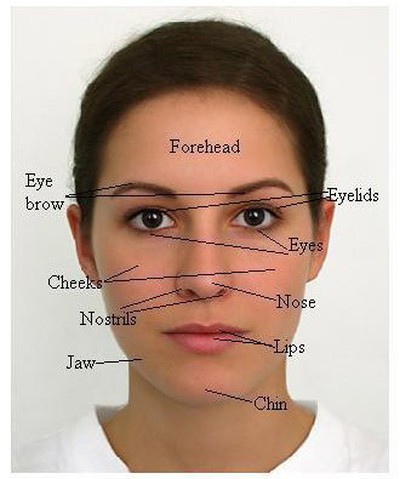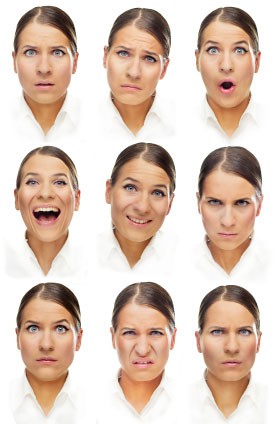Abstract
Okay, now you've done it. You goofed off, didn't study for your math test, and didn't do well. Mom and Dad are not going to be happy. In fact, they might even be angry. They don't say anything when they see your test, but you can tell from their faces that they are angry. But how can you tell? How can you tell if someone is angry, or happy, or sad? The answer is that you have learned how to tell someone's emotional state from his or her facial expressions. Are facial expressions of happiness or sadness universal? In other words, do all cultures and people express emotions on their faces in the same way? What makes up a happy face or a scared face? In this human behavior science project, you will survey a group of test subjects to determine if you recognize emotions using facial expressions, and what cues on the face you use to determine emotion.Summary
Michelle Maranowski, PhD, Science Buddies

Objective
To determine how humans perceive emotions, using cues from facial expressions.
Introduction
Has anyone ever said to you, "Hey, you look really happy!" or "What's the matter? You look really sad"? How can someone tell if you are happy or sad? Probably because they are reading your facial expression. The human face can convey a person's emotional state. Facial expressions are a form of nonverbal communication that is often used to complement verbal communication. For example, if someone surprised you, you might exclaim, "Oh!" and your eyes and mouth would widen. Your head and body might move back a bit, as well. Figure 1 shows many different facial expressions. Can you figure out the emotion behind each facial expression?
 Image Credit: istock / istock subscription
Image Credit: istock / istock subscription
Figure 1. This young woman is demonstrating several different facial expressions. (iStock.com, 2008.)
Facial expressions are a result of our facial muscles working together. For example, a genuine happy face is characterized by the raising of the corner of the lips, the raising of the upper areas of the cheeks, and narrowing of the eyelids. A face expressing genuine anger is characterized by lowered eyebrows that are pulled together to form wrinkles in the skin of the forehead, tensed and straightened lower eyelids, and tension in the lips and mouth. Paul Ekman and Walter Friesen are psychologists who developed the Facial Action Encoding System (FACS) to measure facial expressions by identifying the muscular activity underlying facial activity. Researchers use the FACS to investigate which facial muscles are responsible for creating a myriad of facial expressions.
The idea of facial expressions indicating emotions was discussed back in the 1800s. Charles Darwin, the father of the theory of evolution, theorized that facial expressions were universal. In other words, Darwin felt that people expressed emotions in the same way, regardless of their race and culture. At the time, and for years after, many anthropologists and psychologists felt that this was incorrect and that facial expressions were culture-specific and did not indicate the expresser's emotional state. Thus, they believed that every culture had its own way of non-verbally expressing the basic emotions of happiness, sadness, fear, surprise, anger, and disgust. However, in the 1960s, a study done by Ekmann and Friesen of the Fore tribesmen of Papua, New Guinea (a pre-literate and isolated culture) showed that the facial expressions of the six basic emotions were universally recognized by this group. The tribesmen were able to look at an image of a facial expression and easily determine the emotion behind the facial expression. Ekman believes that facial expressions evolved as a way to signal to others how they feel, as well as future actions. For example, an angry facial expression signals that the expresser may be ready to attack. Still, the question of whether facial expressions universally indicate certain emotions is a hotly debated issue in the field of psychology.
In this human behavior science project, you will investigate whether people can determine the emotional state of the expresser using the expresser's facial expression. Also, you will see what actions in the face allow the perceiver to determine the emotional state of the expresser. For example, can your test subject (the perceiver) tell when the expresser is happy? What is it about the face that allows the test subject to make this conclusion? Is it because the eyelids are narrowed and the lips are turned up? Do most of your test subjects recognize an angry face because the mouth and lips and tensed? By the end of this science project, you might just become an expert at reading facial expressions!
Terms and Concepts
- Facial expression
- Emotion
- Nonverbal communication
Questions
- Which facial muscles are used to make you smile? What about to make you frown?
- What are some of the different non-verbal communications that people of different cultures exhibit?
- From your research, can you describe practical applications of the study of facial expressions?
- Has the study of facial expressions created areas of further study?
- Do infants exhibit and understand facial expressions?
Bibliography
- Ekman, P. (2003, April). Facial Expression and Emotion. American Psychologist. Vol. 48, No. 4, 376-379.
The following reference is Dr. Paul Ekman's website. Watch the video Conversations with History to learn more about how Dr. Ekman developed the science of reading faces.
- Paul Ekman Group, LLC. (2009). Dr. Paul Ekman: Cutting Edge Behavioral Science for Real World Application. Retrieved January 18, 2010.
This reference discusses the difference in opinion that researchers have when discussing whether facial expressions are linked to emotions.
- Azar, B. (2000, January). What's in a Face? Monitor on Psychology. Vol. 31, No. 1. Retrieved January 18, 2010.
Materials and Equipment
- Adult volunteer (1)
- Camera. A digital camera is best since it will allow you to see your results quickly.
- Optional: Printer
- Test subjects, at least 50 volunteers from the age of 6 years to 12 years old. Try to have an even mix of females and males. You could recruit test subjects at your school, from community sports groups, or from schools your friends or siblings attend.
- Quiet location for testing
- Table
- Chairs (2)
- Lab notebook
- Graph paper
Experimental Procedure
Working with Human Test Subjects
There are special considerations when designing an experiment involving human subjects. Fairs affiliated with Regeneron International Science and Engineering Fair (ISEF) often require an Informed Consent Form (permission sheet) for every participant who is questioned. Consult the rules and regulations of the science fair that you are entering, prior to performing experiments or surveys. Please refer to the Science Buddies documents Projects Involving Human Subjects and Scientific Review Committee for additional important requirements. If you are working with minors, you must get advance permission from the children's parents or guardians (and teachers if you are performing the test while they are in school) to make sure that it is all right for the children to participate in the science fair project. Here are suggested guidelines for obtaining permission for working with minors:
- Write a clear description of your science fair project, what you are studying, and what you hope to learn. Include how the child will be tested. Include a paragraph where you get a parent's or guardian's and/or teacher's signature.
- Print out as many copies as you need for each child you will be surveying.
- Pass out the permission sheet to the children or to the teachers of the children to give to the parents. You must have permission for all the children in order to be able to use them as test subjects.
Collecting Data
-
While you are waiting to get permission from all of your test subjects, begin preparing for the experiment.
- Ask your adult volunteer to pose for pictures of the six basic emotions: Happy, sad, afraid or fearful, surprised, disgusted, and angry. To help your volunteer prepare his or her facial expressions, ask your volunteer to think of situations that make him or her feel the six basic emotions.
- When you are ready to take the picture, have the volunteer look directly into the camera and hold the pose for a few seconds. Take a picture only of his or her face. Take pictures of your volunteer showing each emotion.
- Immediately review the photographs to make sure that the images are clear and that you are happy with the results.
- Print out the six facial expressions on photo paper on your home printer or have them printed out at a local store. Print out large versions of the images on 8 ½-in. X 11-in. photo paper. On the back of each image, write out the emotion that the volunteer is expressing.
- Once you have received all of the permission slips from your test subjects, start testing the test subjects. Find a quiet room at your school, library, or home. Set up the table. Set up the two chairs across from each other at the table.
- Have a test subject come in and ask him or her to sit in one of the chairs. Let the test subject know that you are working on a science project about facial expressions and that you will be having him or her look at six different pictures of facial expressions. In your lab notebook, record the age and gender of your test subject in a data table.
-
Show the test subject an image of the human face, like the one shown in Figure 2, to help him or her think about the parts of the human face. Keep this image available on the table so that the test subject can refer to it.
 Image Credit: Initial image from University of Regensburg. Image modified by Michelle Maranowski / Permission granted by Dr. Gruendl, University of Regensburg
Image Credit: Initial image from University of Regensburg. Image modified by Michelle Maranowski / Permission granted by Dr. Gruendl, University of RegensburgPhoto of woman's face has labels for the forehead, eye brows, eyelids, eyes, cheeks, nose, notrils, lips, jaw and chin.
Figure 2. Parts of the human face. (Image courtesy of M. Gruendl, University of Regensburg, 2002.)
- Now show the test subject the first picture. Ask him or her to identify the emotion that he or she thinks your volunteer was expressing. Record this data in the data table in your lab notebook.
- Next, ask the test subject how he or she can tell—what cues from the face led him or her to believe that the person in the image is expressing the displayed emotion. Record everything that the test subject describes about the face in the image in the data table of your lab notebook.
- Repeat steps 4–6 for the rest of the images. Carefully record the data for each image in a data table in your lab notebook.
- Once the test subject has reviewed each image and you have recorded all of his or her observations in your lab notebook, the test subject is done. Thank him or her for participating and let him or her leave.
- Repeat steps 3–8 for all of the test subjects.
Analyzing the Data
- Review your data. In a separate table in your lab notebook, record how many test subjects were able to correctly match the emotion to the facial expression displayed in each image, and how many test subjects were not able to correctly match the emotion to the facial expression displayed in each image. Present this data graphically for each image/facial expression.
-
For each test subject, separate the data you recorded by how he or she was able to tell the emotion behind the facial expression in each image. Record this data in another table in your lab
notebook. Make a table for each facial expression. Create columns in each data table for every part of the face (e.g., eyebrows, forehead, eyelids and eyes, cheeks, nose, mouth and lips, jaw, and chin).
- Perhaps the test subject described the displayed facial expression as anger because the eyebrows were lowered, the mouth was tensed, and the lips were straight. You would then, for example, place a checkmark in the column Eyebrows, along with writing the word lowered, and a checkmark in the column Mouth and Lips, along with writing the words tense and straight.
- Analyze the data for each test subject and for each facial expression and record the data.
- Now create another data table in your lab notebook for each facial expression. In each table, again create a column for all of the different parts of the face. This time, record the tally from among the test subjects that correctly determined the emotion, meaning the part(s) of the face that helped each test subject figure out the emotion behind the facial expression.
- Plot the data from step 2c. Label the x-axis Part of Face and the y-axis Tally.
- What conclusions can you make about how humans perceive emotions from facial expressions? What parts of the face or facial cues (e.g. tense lips, furrowed forehead) help us decipher facial expressions? Were there any facial expressions that were difficult to decipher? Why were they difficult to decipher?
Ask an Expert
Variations
- Does the ability to decipher facial expressions depend on gender? Does the ability to decipher facial expressions depend on age? Split up your data differently to find out.
- Repeat the tests, but cover up part of the face in the image. For example, just show the eyes. How does this affect the number of people who pick the correct emotion?
- For another science project exploring the science behind facial expressions, try That's a Real Smile!...or is it?
Careers
If you like this project, you might enjoy exploring these related careers:









